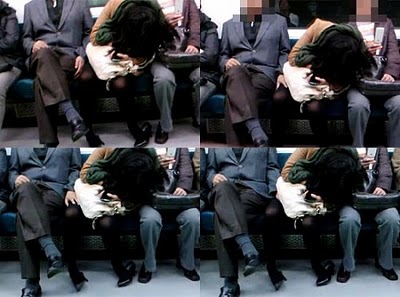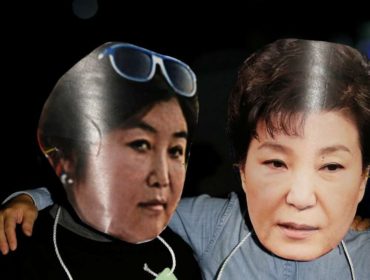By Marie Kulik with Iwazaru
A Look at the Summer Months
At 8:30 a.m. on the morning of April 21, a man sexually assaulted a woman by rubbing his body up against her in a packed subway car going from Jamsil Station in south eastern Seoul to Seoul National University of Education Station on line No. 2. Undercover police witnessed the crime and apprehended the man. The suspect, surprisingly (or not), turned out to be a judge on the Seoul High Court by the name of Mr. Hwang. He submitted his resignation to the Supreme Court the next day.
Shocking as it may be to have a judge molesting a woman in public, the fact is that sex offences are on the rise. Specifically, sexual assault on the subway, serious and otherwise (or the rate of people having a good go at it) has risen by 77.6% in 2011, compared to years previous.
According to the Seoul National Police Agency, by way of a reporter at Yonhap, the following figures make up this drastic rise.
In 2010, there were 671 reported cases of the sexual assault of passengers on the subway. In May of 2010, 550 of these took place. By June of 2011, there had been 1192 reported cases of the sexual assault of passengers on the subway. Nearly seven hundred of these had taken place in the month of May.
Whilst it is not at all clear whether the rise in figures opposed to incidences is due to the simple case of assaults being reported to authorities where once they were not, these are unquestionably high numbers. It has been proposed that the general rise of attacks per year in May is due to the sun coming out, the temperature rising and women dressing more liberally (some have pointed to the rapidly rising hemlines seen these days and the increased sexualization of women in Korea).
To put it into further perspective, 2009 saw some bad press for Manhattan Island, when it was reported that there had been a 4% rise in sexual assaults city wide that year to a total of 587 counts, with 374 taking place on the subway (largely between Grand Central Terminal and 14th Street, so plan your trip accordingly).
On the note of the where and when, this year in Seoul 50.9% (280 people) of assaults have taken place on Line 2, 26.5% (146) on Line 1, 10.7% on Line 4, 3.8% on Line 7, 3.1% on Line 3, 2.3% on Line 5 and lastly 1.2% on Line 9.
Friday appears to be the worst day for it with a sexual assault average of 20% (110 people per Friday). The second worst day is Wednesday accounting for 18.5% percent of incidences (102 people). The other days of the week seem very much hit or miss with no solid median to be drawn.
On the train itself, (where 69.3% of all cases have taken place) the morning rush hour of 0800 – 1000 pulls 39.1% of all cases, with 26.4% occurring between 1800 and 2000.
Official police advice is that swift help is not possible if you report your case as a text message, so should you need to make contact with law enforcement, dial 112.
According to two documents entitled Analytical Report on Crimes 170-171 and Analytical Report on Crimes 162-163, commissioned by the South Korean Supreme Prosecutors Office in 2009 and 2005 respectively, reported cases of rape against adults had risen by 46%, whilst reported cases of rape against those under 16 years of age had increased by 81% by the end of 2008 when compared to the last four years.
Consequently, between 2008 and 2010, the National Assembly turned its spotlight to the matter of how to dish out harder punishment for sex offences and moreover, how to deal with the growing problem.
Despite some unfortunate statistics coming to light during this process (sexual crimes by foreign nationals had tripled since 2001 from 83 that year to 242 in 2008 – which was largely due to the influx of foreigners between these years) it was deduced that more legislation needed to be put in place to counter the issue. By December 2010, five legislative actions had been written, three new acts adopted and two amended to a harsher degree.
Briefly, the most of interesting of the new consequences of a ‘Deviant’ sex act of which one is convicted are as follows:
(Amended) The Act on the Electronic Monitoring of Special Criminal Offenders, Act No. 10257 of Apr. 15, 2010 – Maximum duration of electronic monitoring increased to 30 years. Doubled if victim is under 13 years of age.
(Amended) The Act on the Protection of Children and Juveniles from Sexual Abuse, Act No. 10391 of July 23, 2010, and the (Amended) Act on Special Cases Concerning the Punishment of Sexual Crimes, Act No. 10258 of Apr. 15, 2010. The Minister of Gender Equality and Family or the Minister of Justice will issue the personal information of a sex offender to the public, whether the victim was below or above 19 years of age, respectively.
The Act on Pharmacologic Treatment of Sexual Offenders’ Sexual Impulse, Act No. 10371 of July 23, 2010 which permits the forcible chemical castration (to include first time offences) for a maximum duration of 15 years.
In a country where one solution currently under trial to counter the threat of abduction and sexual assault against children is to tag your kid with a GPS system, this may come as no major surprise. In October 2010, 1,200 elementary school students in Anyang City were issued with a piece of kit a that automatically attracts all nearby CCTV cameras to their position and makes contact with their parents and police via cell phone to indicate their whereabouts. The Ministry of Public Administration and Security is considering this system for nationwide use. This happened after the abduction and brutal rape of an 8-year-old girl.
Whilst the question ‘Why are men more inclined to assault attractive women in summer dress?’ might seem like a no-brainer to those inclined to answer that the women are dressed provocatively, this answer has a history of being deeply unproductive and statistically irrelevant. Sadly and for the most part, it appears as though this is still for the moment the consensus amongst law-makers in South Korea.
In South Korea, rape rises in the winter months, most likely due to longer nights and the far less populated streets in the late hours. In the summer opportunism looks to drive, when it is far easier to touch the skin of a woman in a skimpy cotton dress than a woman wearing a winter duffle coat.
Consequently, there are no simple answers here.
Six randomly selected women from six different areas of Seoul between the ages of 23-33 were questioned by a researcher for this article; whether it  be the sensitivity of the subject or the nature of the city, unfortunately none gave permission to be identified. Of the six women, three claimed that they had been sexually assaulted whilst on the subway, of these three two claimed that they knew a friend who had been sexually assaulted on the subway and one had to physically fight off an attacker on the subway to stop the situation from escalating. Two others claimed that they had been sexually assaulted off of the subway. One woman had had no bad experience and knew of nobody whom a sexual assault had happened to.
be the sensitivity of the subject or the nature of the city, unfortunately none gave permission to be identified. Of the six women, three claimed that they had been sexually assaulted whilst on the subway, of these three two claimed that they knew a friend who had been sexually assaulted on the subway and one had to physically fight off an attacker on the subway to stop the situation from escalating. Two others claimed that they had been sexually assaulted off of the subway. One woman had had no bad experience and knew of nobody whom a sexual assault had happened to.
Not a single woman had notified the police.
As the country continues to develop and change and ever more people continue to relocate from elsewhere to Seoul, sociological feelings will change also. In recent years, Korean woman both nationwide and in Seoul have no doubt become more open to the subject of both sexuality and being sexual, without being inevitably labelled as a slut by other women. Consequently, potential elements of a more conservative Korean male populous may see this show of female sexual confidence as a challenge, both from a Law Enforcement and social perspective.
Invariably, one of the oldest arguments in history will continue to be fought. Does a provocatively (as perceived by the attacker) dressed woman, justify the actions of the attacker? From an editorial perspective I am going to go out on a whim here and say no, obviously not. Does a provocatively dressed woman incite the sort of lunatic who can justify sexually assaulting a woman to do so? Perhaps. Perhaps, more importantly, if the same woman was wearing a potato sack, would the attacker do the same given the opportunity? Most likely.
As with almost all cases of crime worldwide, statistics bear little resemblance to something as obvious as background, class, education or social standing. The same applies in South Korea.
Most recently, three male medical students in their final year at Korea University, a prominent school, are being investigated by the Seongbuk Police Department.
They are under the suspicion that as a group they sexually assaulted an inebriated female student whilst on a field trip to Gapyeong, Gyeonggi Province on May 21, 2011. They had studied alongside the woman for six years.
The allegation made by the female student, centres around the female student falling asleep in the property in which the three males were staying. The woman was stripped and molested, with the incident captured on their cell phones. The woman has also claimed to the Korea Sexual Violence Relief Center that she was raped.
The three men, sons of prominent doctors and lawyers have admitted to the Seongbuk Police Department to stripping and touching the girl, but deny rape. The South Korean National Forensic Service are to further investigate the woman, examine clothes and to try to recover further footage (which was deleted by the men as the police asked for their phones).
According to a Police spokesman, “If it is confirmed they raped her, we’ll seek arrest warrants”. Korea University has claimed that they would consider the expulsion of the three male students if they are convicted of rape.
The men have not been arrested, despite having admitted to documented sexual assault.
“It’s a Korean thing…” says a barman in the escort district of Apgujeong, “…nothing you can do”.








